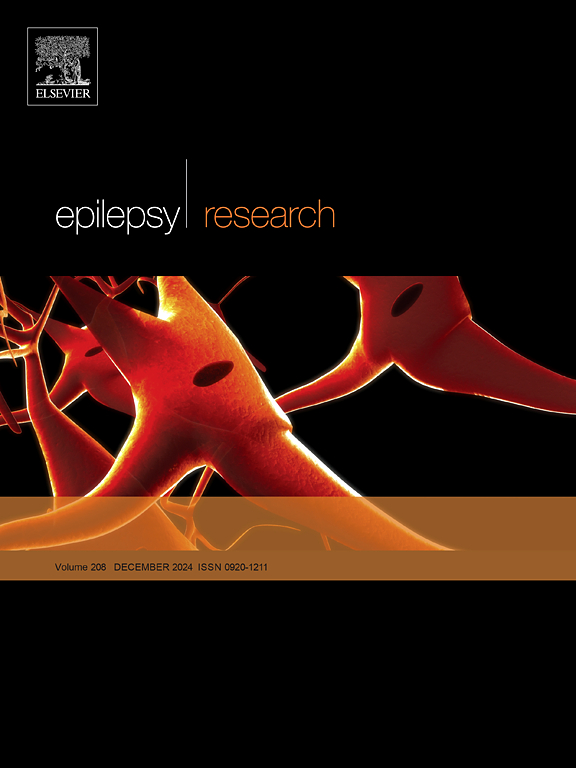Pharmacological inhibition of PLC and PKC triggers epileptiform activity in hippocampal neurons
IF 2
4区 医学
Q3 CLINICAL NEUROLOGY
引用次数: 0
Abstract
Calcium signaling pathways play a crucial role in neuronal and glial function, yet the effects of inhibiting specific components of these pathways remain poorly understood. Here, we investigated how various inhibitors affect calcium dynamics in neurons and astrocytes within hippocampal co-cultures under normal conditions and during bicuculline-induced epileptiform activity. We found that phospholipase C (PLC) inhibitor U73122 and protein kinase C (PKC) inhibitors BIM IX and Go 6976 independently induced epileptiform activity in neurons, characterized by synchronized calcium oscillations similar to those caused by bicuculline. Notably, these inhibitors did not affect astrocytic calcium dynamics. In contrast, IP3 receptor inhibitor 2-APB and calmodulin inhibitor calmidazolium triggered significant calcium responses in both neurons and astrocytes. The 2-APB application led to an immediate increase in neuronal calcium levels and cessation of calcium oscillations, while also inducing varied calcium responses in astrocytes. Calmidazolium caused elevated calcium levels in both cell types, with neurons maintaining calcium oscillations at increased baseline levels. Interestingly, PI3 kinase inhibitor AS-605240 and ryanodine receptor inhibitor dantrolene showed no significant effects on calcium dynamics in either cell type. Electrophysiological recordings confirmed that both PLC and PKC inhibition induced paroxysmal depolarization shifts similar to those observed during bicuculline-induced epileptiform activity. These findings reveal previously unknown effects of commonly used signaling pathway inhibitors on neuronal excitability and calcium homeostasis, which should be considered when designing experiments and interpreting results involving these compounds. Our results also suggest a potential role for PLC and PKC in maintaining the excitation-inhibition balance in neuronal networks.
PLC和PKC的药理抑制可触发海马神经元的癫痫样活动
钙信号通路在神经元和神经胶质功能中起着至关重要的作用,然而抑制这些通路的特定成分的作用仍然知之甚少。在这里,我们研究了在正常条件下和在双球茎碱诱导的癫痫样活动期间,各种抑制剂如何影响海马共培养中神经元和星形胶质细胞中的钙动力学。我们发现磷脂酶C (PLC)抑制剂U73122和蛋白激酶C (PKC)抑制剂BIM IX和Go 6976分别诱导神经元的癫痫样活动,其特征是同步钙振荡,类似于双核碱引起的。值得注意的是,这些抑制剂不影响星形细胞钙动力学。相比之下,IP3受体抑制剂2-APB和钙调素抑制剂calmidazolium在神经元和星形胶质细胞中都引发了显著的钙反应。2-APB的应用导致神经元钙水平的立即增加和钙振荡的停止,同时也在星形胶质细胞中诱导不同的钙反应。卡咪达唑引起两种细胞类型钙水平升高,神经元维持钙振荡在增加的基线水平。有趣的是,PI3激酶抑制剂AS-605240和ryanodine受体抑制剂dantrolene对两种细胞类型的钙动力学均无显著影响。电生理记录证实,PLC和PKC抑制均引起阵发性去极化移位,类似于二花碱诱导的癫痫样活动。这些发现揭示了以前未知的常用信号通路抑制剂对神经元兴奋性和钙稳态的影响,在设计实验和解释涉及这些化合物的结果时应考虑到这一点。我们的研究结果还表明,PLC和PKC在维持神经元网络的兴奋-抑制平衡方面具有潜在的作用。
本文章由计算机程序翻译,如有差异,请以英文原文为准。
求助全文
约1分钟内获得全文
求助全文
来源期刊

Epilepsy Research
医学-临床神经学
CiteScore
0.10
自引率
4.50%
发文量
143
审稿时长
62 days
期刊介绍:
Epilepsy Research provides for publication of high quality articles in both basic and clinical epilepsy research, with a special emphasis on translational research that ultimately relates to epilepsy as a human condition. The journal is intended to provide a forum for reporting the best and most rigorous epilepsy research from all disciplines ranging from biophysics and molecular biology to epidemiological and psychosocial research. As such the journal will publish original papers relevant to epilepsy from any scientific discipline and also studies of a multidisciplinary nature. Clinical and experimental research papers adopting fresh conceptual approaches to the study of epilepsy and its treatment are encouraged. The overriding criteria for publication are novelty, significant clinical or experimental relevance, and interest to a multidisciplinary audience in the broad arena of epilepsy. Review articles focused on any topic of epilepsy research will also be considered, but only if they present an exceptionally clear synthesis of current knowledge and future directions of a research area, based on a critical assessment of the available data or on hypotheses that are likely to stimulate more critical thinking and further advances in an area of epilepsy research.
 求助内容:
求助内容: 应助结果提醒方式:
应助结果提醒方式:


